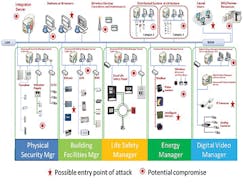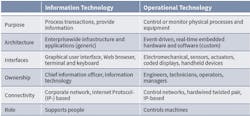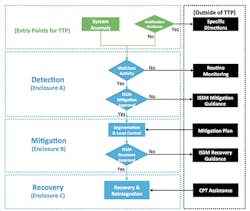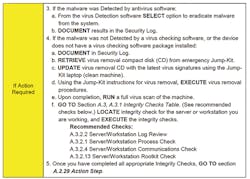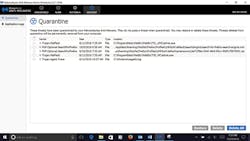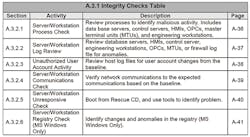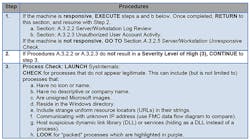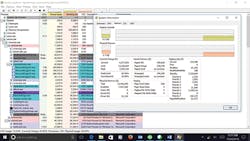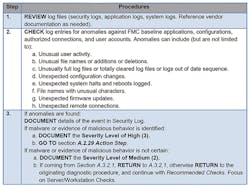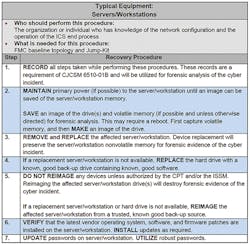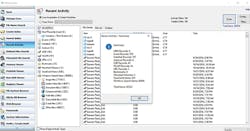Building owners and managers, facility engineers, and physical-security specialists, be warned: Building control systems (BCS) are now squarely in the sights of nation-state and criminal hackers. With the increased likelihood of BCS being attacked/exploited, U.S. Cyber Command (USCYBERCOM) developed the document “Advanced Cyber Industrial Control System Tactics, Techniques, and Procedures (ACI TTP) for Department of Defense (DoD) Industrial Control Systems (ICS).” (Note: The use of the word “industrial” can be misleading; the ACI TTP can be applied to any control system.) This article discusses use of the ACI TTP for detecting, responding to, and recovering from a cyber attack.
BCS Basics
BCS, such as building-automation systems (BAS), energy-management systems, physical-security access-control systems, and fire-alarm systems, are hacking points into an organization (Figure 1). Such control systems often are referred to as operational technologies (OT) and use a combination of traditional information-technology (IT) protocols—Transmission Control Protocol (TCP) or User Datagram Protocol (UDP)—and control systems with unique protocols (e.g., Modbus, BACnet, LonTalk, DNP3 [Distributed Network Protocol]) to communicate with sensors, devices, and actuators.
BCS are an easy target for hackers and people with malicious intent because they are unsecured by design, the desire being remote access and an ability to operate with minimal staffing. With smart buildings, instead of several vertical chases connecting telecommunications rooms and redundant communications and power pathways, the trend is to collapse IT and OT traffic onto a single fiber; use Power over Ethernet (PoE) switches to provide low power voltage to OT devices, such as card readers, magnetic door locks, closed-circuit television, and medical devices and equipment; and eliminate redundant pathways to gain additional rentable floor space. In most organizations, the IT department now is responsible for converged infrastructure, yet has no to little training on detecting, removing, and recovering from malware directed at BCS.
BCS can be exploited to gain physical access to facilities and virtual access to traditional IT systems and data and to damage or destroy building equipment, exposing organizations to significant financial obligations for containment, eradication, and/or recovery in the process.
Finding BCS on the Internet
There are many tools for monitoring network security. One of the most powerful is Shodan. In the majority of cases, clicking on an Internet Protocol (IP) address will open the login to an operator console. In many cases, the browser is using unencrypted Hypertext Transfer Protocol (HTTP) port 80, rather than encrypted HTTPS (also called HTTP over Transport Layer Security [TLS], HTTP over Secure Sockets Layer [SSL], and HTTP Secure) port 443, meaning the login credentials are being sent as open text across the Internet. BCS should not be exposed to direct Internet connections; they should be in a demilitarized zone (DMZ) with perimeter-protection firewalls, require a virtual-private-network connection, and be separate from business IT systems.
IT is about data; OT is about controlling machines (Table 1). Increasingly, OT is becoming more IP-based. The Internet of Everything, smart grids, smart cities, smart buildings, and smart cars are redefining the boundary between IT and OT. As IT and OT systems converge, so are the vulnerabilities of OT systems as points of entry. Once a hacker enters a system, it is just a matter of pivoting up the network and taking control of OT- and IT-system assets.
The Development of the ACI TTP
The ACI TTP were developed over 18 months by pairing IT and OT operators and providing basic training in typical IT and OT operations; cyber-attack-event detection, mitigation, and recovery; and forensics. The teams then practiced stopping a nation-state-type attack, recording the procedures they used to defend their control systems.
The teams’ responses became the ACI TTP, which were published in January 2016. The ACI TTP apply to IT systems—business and home—and OT systems of any kind.
The ACI TTP document is divided into essentially four sections:
- ACI TTP concepts. Chapters 2 through 4 explain the scope, prerequisites, applicability, and limitations of the components of the ACI TTP.
-
Threat-response procedures (Figure 2). These encompass:
- Detection procedures designed to uncover malicious cyber activity as soon as possible. The basic actions involved with detection are routine monitoring and inspection and transition to mitigation procedures. Detection procedures are designed to enable control-system (CS) and IT personnel to identify malicious network activity using official notifications of system anomalies not attributed to hardware or software malfunctions.
- Mitigation procedures, which involve analysis, response, and a course of action. Normally, all data should be acquired and preserved for further analysis. Sometimes, however, the need to keep a system operational precludes the collection of data. In such cases, the command authority must approve the noncompletion of data acquisition. Whatever response a situation calls for, organizations must be prepared, as decisions made in haste could lead to unintended consequences. Therefore, procedures, tools, interfaces, and communications channels and mechanisms should be tested and in place. Plans should list specific steps to take and identify the necessary personnel by job description. Escalation procedures and criteria must be established and acceptable risks for incident containment defined. This can be done during annual risk-management activities.
- Recovery procedures. A cyber-protection team (CPT) from outside an organization may be called upon to direct a recovery process. The main focus of a CPT should be to preserve forensic evidence for analysis and to provide technical assistance as needed. If directed, an operator may proceed with recovery without the assistance of an outside CPT. In any event, whenever feasible, every effort should be made to preserve evidence of a cyber incident for forensic analysis. Forensic-evidence collection for BCS is very difficult and time-consuming, as most building controllers do not have logs, are not authenticated, and are on unencrypted networks.
- Routine monitoring and baselining. Capture the “fully mission-capable” (FMC) condition of network entry points (e.g., firewalls, routers, remote-access terminals, wireless access points), network topology, network data flow, and machine/device configurations. The FMC baseline is used to determine normal operational conditions vs. anomalous conditions. A recovery jump kit contains the tools BCS and IT teams need to restore a system to its FMC state during mitigation and recovery. Knowing what the recovery point should be is the key to ensuring all known remnants of an attack have been removed from all components of an ICS. This means all hardware and software are configured in accordance with operational requirements and checksums and hashes are in conformance with vendor specifications.
- Reference materials. To further enhance the ACI TTP as a tool, operators are encouraged to refer to additional resources provided by the Industrial Control Systems Cyber Emergency Response Team (ICS-CERT) and the National Institute of Standards and Technology (NIST) Special Publication (SP) 800 Computer Security series.
Example of Server/Workstation Anomalies
To illustrate the use of the ACI TTP, we are going to use the Havex malware alert and exploit documented by ICS-CERT and European cybersecurity company F-Secure. ICS-CERT described the vulnerability and how to mitigate it and provided a YARA signature, used to identify and classify malware. F-Secure provided additional research and analysis:
Our analysis of Havex sample codes also uncovered its "ICS/SCADA (supervisory control and data acquisition) sniffing" behavior. The C&C (command and control) server will instruct infected computers to download and execute further components, and one of these components appeared very interesting. While analyzing this component, we noticed that it enumerates the local area network and looks for connected resources and servers. ...
We then noticed that it uses Microsoft (MS) Component Object Model (COM) interfaces (CoInitializeEx, CoCreateInstanceEx) to connect to specific services. ...
To identify which services the sample is interested in, we can simply search for the identifiers seen above, which tell us what kind of interfaces are being used. A bit of googling gives us these names:
- 9DD0B56C-AD9E-43EE-8305-487F3188BF7A = IID_IOPCServerList2
- 13486D51-4821-11D2-A494-3CB306C10000 = CLSID_OPCServerList
Note the mention of "OPCServer" in the names. There are more hints pointing in the same direction -- the strings found in the executable also make several references to "OPC." ...
... OPC stands for OLE for Process Control, and it’s a standard way for Windows applications to interact with process control hardware. Using OPC, the malware component gathers any details about connected devices and sends them back to the C&C for the attackers to analyze.
MS operating systems are used in over 90 percent of BCS deployments. An analysis by the DoD found Windows XP on 70 percent or more of BCS (both DoD and commercial). Only systems 5 years old or newer might be on Windows 7, 8, or 10. Very few BCS have been virtualized. They all share the OPC vulnerability.
Figure 3, taken from the ACI TTP document, shows server/workstation anomalies. In the case of A.2.4—suspicious software/configurations—the user is directed to the detection procedure on Page A-8 (Figure 4). The procedure instructs the CPT to perform a virus/malware quarantine and removal function, capture forensics information, and document the actions in a security log.
Malware can be quarantined and removed using antivirus tools such as Malwarebytes (Figure 5). Hackers like to install malware into memory, which makes the malware harder to find.
Next, users are advised to run server/workstation-integrity checks (Figure 6).
To check for processes that do not appear legitimate, launch MS Sysinternals (figures 7 and 8). Check Sysinternals Autoruns, Process Explorer, and Process Monitor; look for high central-processing-unit (CPU) and memory usage; and compare against process and threads (Figure 9).
If a server/workstation has been exploited and antivirus/malware-removal efforts have been unsuccessful, the ACI TTP advises users to proceed to recovery procedures (Figure 10).
Many BCS do not monitor underlying infrastructure. For checking firewalls, networks, and applications for suspicious threads, processes, and CPU and memory usage, a number of tools, such as GlassWire (Figure 11) and the Sysinternals suite combined with the MS Enhanced Mitigation Experience Toolkit (EMET), are available.
Forensics data-gathering tools, such as OSForensics (Figure 12) and Mandiant Redline, create a forensics copy of drives and perform detailed computer-usage analysis.
Conclusion
This is just a snippet of the effort required to actively defend a BCS. Unfortunately, at this time, there are very few fully automated tools that can look at a BCS from the end-point device to the server/workstation human-machine interface and determine the health and cyber status of the system. As new products that enable machine-to-machine and end-to-end analysis are developed, the level of effort will decrease while overall cybersecurity increases. Until that time, BCS owners/operators should familiarize themselves with, budget for, and plan to implement the ACI TTP.
Summary
At some point in the not-too-distant future, a major building’s control system will be hacked, leading to significant physical and economic damage. In general, very few organizations have the skills and training to identify, much less respond to, an active attack/exploit situation. The ACI TTP are an organization’s first line of defense, aiding the detection and mitigation of threats and the restoration of a BCS to normal operation. The Whole Building Design Guide cybersecurity resource page provides BCS Cyber 101, while the National Institute of Building Sciences’ Cybersecurity for Building Control Systems Workshop Series (see sidebar “Cybersecurity Workshop Set”) is designed to help architects, engineers, contractors, owners, facility managers, maintenance engineers, physical-security specialists, information-assurance professionals—essentially anyone involved in cybersecurity over a facility’s life cycle—to learn best-practice techniques for better protecting their facilities.
SIDEBAR: Cybersecurity Workshop Set
On Dec. 6 in Gaithersburg, Md., the authors will present “Your Building Control Systems Have Been Hacked, Now What?,” part of the National Institute of Building Sciences’ Cybersecurity for Building Control Systems Workshop Series. Intended for building owners, facility managers, engineers, and physical-security, information-assurance, and other professionals involved in the design, deployment, and operation of building control systems, the workshop will provide a combination of classroom learning modules and hands-on laboratory exercises to teach how to detect, contain, eradicate, and recover from a cyber event. The cost is $300. For more information and to register, click here.
Michael Chipley, PhD, GICSP, PMP, LEED AP, is a consultant to federal agencies and private-sector clients; contributor to National Institute of Standards and Technology (NIST) Special Publication (SP) 800-82 Revision 2 (R2), Guide to Industrial Control Systems (ICS) Security, and the Department of Homeland Security (DHS) Cyber Security Evaluation Tool (CSET); and creator of the National Institute of Building Sciences’ Cybersecurity for Building Control Systems Workshop Series. He can be contacted at [email protected]. Daryl Haegley, OCP, CCO, has been leading efforts to cybersecure U.S. Department of Defense (DoD) facility-related control systems; is a contributor to NIST SP 800-82 R2, DHS CSET, and Unified Facilities Criteria 4-010-06, Cybersecurity of Facility-Related Control Systems; and is a guest lecturer on cybersecuring DoD control systems for National Defense University and The Institute of World Politics. He can be reached at [email protected]. Eric J. Nickel, RCDD, GICSP, CPT, CEH, is a technical expert with over 19 years of experience in design-build project delivery of turnkey secure information-transport systems. He is the information-technology and infrastructure director for Chinook Systems Inc., a multidisciplinary facilities-engineering firm focused on life-cycle energy-security solutions. He can be reached at [email protected].
Did you find this article useful? Send comments and suggestions to Executive Editor Scott Arnold at [email protected].











